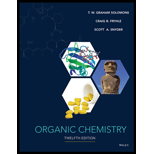
Interpretation:
The explanation for the given statement is to be provided and the way by which this answer is given for the reaction is to be shown.
Concept introduction:
Electrophiles are electron-deficient species, which has positive or partially positive charge. Lewis acids are electrophiles, which accept electron pair.
Nucleophiles are electron-rich species, which has negative or partially negative charge. Lewis bases are nucleophiles, which donate electron pair.
Substitution reaction: A reaction in which one of the hydrogen atoms of a hydrocarbon or a
Nucleophilic substitution reaction is a reaction in which an electron-rich nucleophile attacks the positive or partial positive charge of an atom or a group of atoms to replace a leaving group.
Reaction sequences involve conversion of one functional group to another, which may also require addition or loss of carbon from the reactant.
These sequences involve a number of steps carried out by different reagents. Sometimes different reagents give the same products.
An
An
The nucleophilic substitutions in which a nucleophile replaces a leaving group are known as
Cyanide ion is a much better nucleophile than ethanol.
Want to see the full answer?
Check out a sample textbook solution
Chapter 6 Solutions
ORGANIC CHEM. VOL.1+2-W/WILEYPLUS
- The following two sets of reactions, ((a) and (b)), show possibilities for arrow pushing in individual reaction steps. Identify which is wrong and explain why. Next, using the correct arrow pushing, label which molecule is the nucleophile and which is the electrophile. (a) (b) H3C :Cl: H3C H,c-i: – →: I-CH3 + :Cl: C-C: H3C / H3C H3C-Cl: C-CH3 H3C : H,C-Cl: H3C-CI: →: I-CH3 + :Cl: H3C :Cl: H3C C-CH3 C-CI: H3C/ H3C H3Carrow_forwardFollowing is a balanced equation for bromination of toluene.(a) Using the values for bond dissociation enthalpies given in Appendix 3,calculate ∆H0for this reaction.(b) Propose a pair of chain propagation steps and show that they add up to theobserved reaction.(c) Calculate ∆H0for each chain propagation step.(d) Which propagation step is rate-determininarrow_forwardb) Refer to the following equation to answer Q3b (i), (ii) and (iii). CH3 H,SO, Н—с—он C-CH3 ? + H2O Но- ČH3 (i) Determine the product of the above reaction. (ii) Name the above reaction. (iii) Propose the mechanism for the above reaction.arrow_forward
- 9. (a) Under certain conditions, the reaction of 0.5 M 1-bromobutane with 1.0 M sodium methoxide forms 1-methoxybutane at a rate of 0.05 mol/L per second. What would be the rate if 0.1 M 1-bromobutane and 2.0 M NaOCH3 were used? (b) Consider the reaction of 1-bromobutane with a large excess of ammonia (NH3). Draw the reactants, the transition state, and the products. Note that the initial product is the salt of an amine (RNH* Br) which is deprotonated by the excess ammonia to give the amine. (c) Show another SN2 reaction using a different combination of an alkoxide and an alkyl bromide that also produces 1-methoxybutane.arrow_forwardDecide whether the reaction below will proceed via an SN1 or SN2 mechanism. (b) Draw structural formula from the major organic product only.arrow_forwardWhen propenal is treated with sodium acetylide, a product is formed whose IR spectrum exhibits a broad absorption between 3200 and 3600 cm¯1, but shows no absorption near 1700 cm-1. (a) Draw the structure of the product. (b) Argue whether the nucleophile adds reversibly or irreversibly to the carbonyl group. CH HC || CH2 1. HC=CNa ? 2. NH,CIarrow_forward
- Pleas explain how this process occurs. Identify SN1, SN2, E2, E1, nucleophiles and electrophiles.arrow_forwardWhen ethyl bromide is added to potassium tert-butoxide, the product is ethyl tert-butyl ether.(a) What happens to the reaction rate if the concentration of ethyl bromide is doubled?arrow_forwardWhen ethyl bromide is added to potassium tert-butoxide, the product is ethyl tert-butyl ether. (a) What happens to the rate if the concentration of potassium tert-butoxide is tripled and the concentration of ethyl bromide is doubled?arrow_forward
- Compound D, shown below, reacts with hydrogen bromide by electrophilic addition. A mixture of two organic compounds, E and F, is formed. CH3 CH₂CH₂ CH3 H compound D HBr Mixture of organic compounds E and F (i) Name the the two organic compounds E and F and show their condensed formula. (ii) Briefly explain the mechanism of the reaction between compound D and hydrogen bromide to form either compound E or compound F. (You can list/state the main steps) (iii) Which compound, E or F is the major product?arrow_forwardPlease explain the synthesis. Identify SN1, SN2, E1, E2, nucleophiles and ekectrophiles.arrow_forwardPeroxides are often added to free-radical reactions as initiators because the oxygen–oxygen bond cleaves homolytically rather easily. For example, the bond-dissociation enthalpy of the O¬O bond in hydrogen peroxide (H¬O¬O¬H) is only 213 kJ>mol (51 kcal>mol). Give a mechanism for the hydrogen peroxide-initiated reaction of cyclopentane with chlorine. The BDE for HO¬Cl is 210 kJ>mol (50 kcal>mol).arrow_forward
